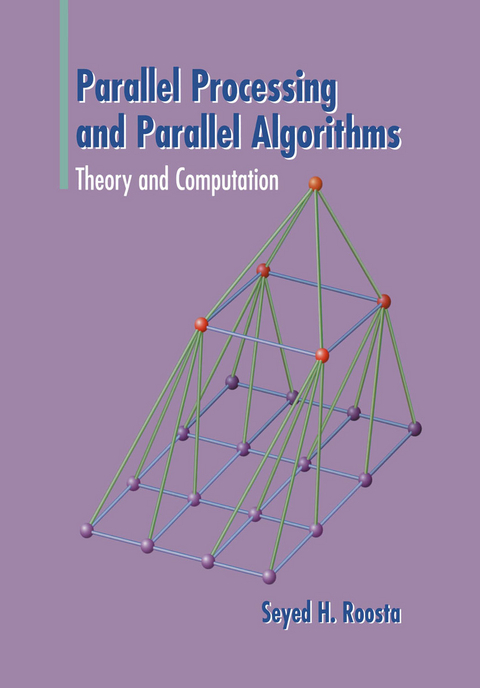
Parallel Processing and Parallel Algorithms
Springer-Verlag New York Inc.
978-1-4612-7048-5 (ISBN)
1 Computer Architecture.- 1.1 Classification of Computer Architectures.- 1.2 Parallel Architectures.- 1.3 Data Flow Architectures.- Summary.- Exercises.- 2 Components of Parallel Computers.- 2.1 Memory.- 2.2 Interconnection Networks.- 2.3 Goodness Measures for Interconnection Networks.- 2.4 Compilers.- 2.5 Operating Systems.- 2.6 Input and Output Constraints.- Summary.- Exercises.- 3 Principles of Parallel Programming.- 3.1 Programming Languages for Parallel Processing.- 3.2 Precedence Graph of a Process.- 3.3 Data Parallelism Versus Control Parallelism.- 3.4 Message Passing Versus Shared Address Space.- 3.5 Mapping.- 3.6 Granularity.- Summary.- Exercises.- 4 Parallel Programming Approaches.- 4.1 Parallel Programming with UNIX.- 4.2 Parallel Programming with PCN.- 4.3 Parallel Programming with PVM.- 4.4 Parallel Programming with C-Linda.- 4.5 Parallel Programming with EPT.- 4.6 Parallel Programming with CHARM.- Summary.- 5 Principles of Parallel Algorithm Design.- 5.1 Design Approaches.- 5.2 Design Issues.- 5.3 Performance Measures and Analysis.- 5.4 Complexities.- 5.5 Anomalies in Parallel Algorithms.- 5.6 Pseudocode Conventions for Parallel Algorithms.- 5.7 Comparison of SIMD and MIMD Algorithms.- Summary.- Exercises.- 6 Parallel Graph Algorithms.- 6.1 Connected Components.- 6.2 Paths and All-Pairs Shortest Paths.- 6.3 Minimum Spanning Trees and Forests.- 6.4 Traveling Salesman Problem.- 6.5 Cycles in a Graph.- 6.6 Coloring of Graphs.- Summary.- Exercises.- 7 Parallel Search Algorithms.- 7.1 Divide and Conquer.- 7.2 Depth-First Search.- 7.3 Breadth-First Search.- 7.4 Best-First Search.- 7.5 Branch-and-Bound Search.- 7.6 Alpha-Beta Minimax Search.- Summary.- Exercises.- 8 Parallel Computational Algorithms.- 8.1 Prefix Computation.- 8.2 Transitive Closure.- 8.3 Matrix Computation.- 8.3.1 Matrix-Vector Multiplication.- 8.3.2 Matrix-Matrix Multiplication.- 8.4 System of Linear Equations.- 8.5 Computing Determinants.- 8.6 Expression Evaluation.- 8.7 Sorting.- Summary.- Exercises.- 9 Data Flow and Functional Programming.- 9.1 Data Flow Programming.- 9.2 Functional Programming.- Summary.- 10 Asynchronous Parallel Programming.- 10.1 Parallel Programming with Ada.- 10.2 Parallel Programming with Occam.- 10.3 Parallel Programming with Modula-2.- Summary.- 11 Data Parallel Programming.- 11.1 Data Parallel Programming with C*.- 11.2 Data Parallel Programming with Fortran 90.- Summary.- Exercises.- 12 Artificial Intelligence and Parallel Processing.- 12.1 Production Systems.- 12.2 Reasoning Systems.- 12.3 Parallelism Analysis.- 12.4 Parallelizing AI Algorithms.- 12.5 Parallelizing AI Architectures.- 12.6 Parallelizing AI Programming Languages.- 12.7 Neural Networks or Parallel Distributed Processing.- Summary.- Exercises.- Author Index.
| Zusatzinfo | XIX, 566 p. |
|---|---|
| Verlagsort | New York, NY |
| Sprache | englisch |
| Maße | 178 x 254 mm |
| Themenwelt | Informatik ► Theorie / Studium ► Algorithmen |
| ISBN-10 | 1-4612-7048-0 / 1461270480 |
| ISBN-13 | 978-1-4612-7048-5 / 9781461270485 |
| Zustand | Neuware |
| Haben Sie eine Frage zum Produkt? |
aus dem Bereich


